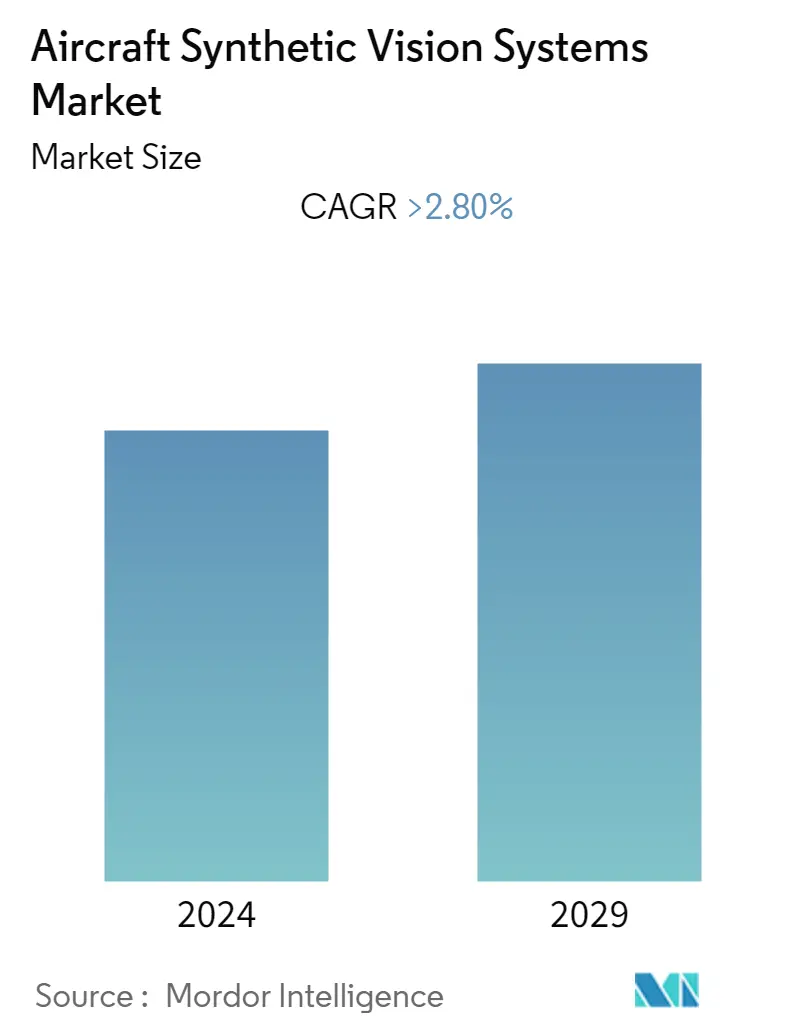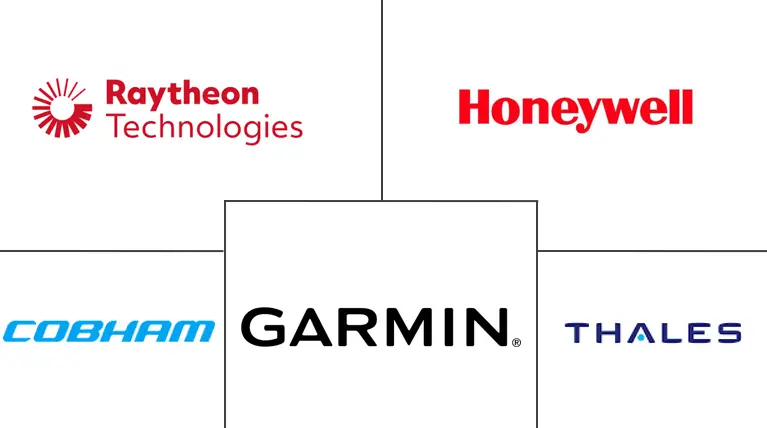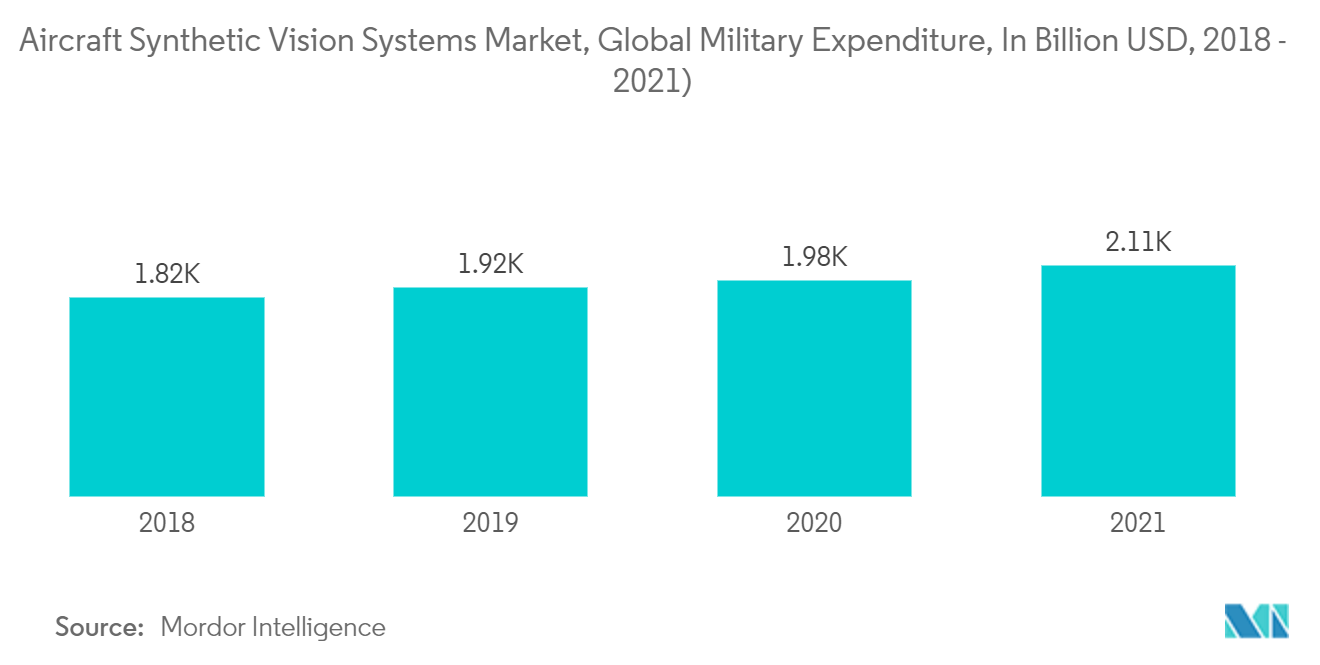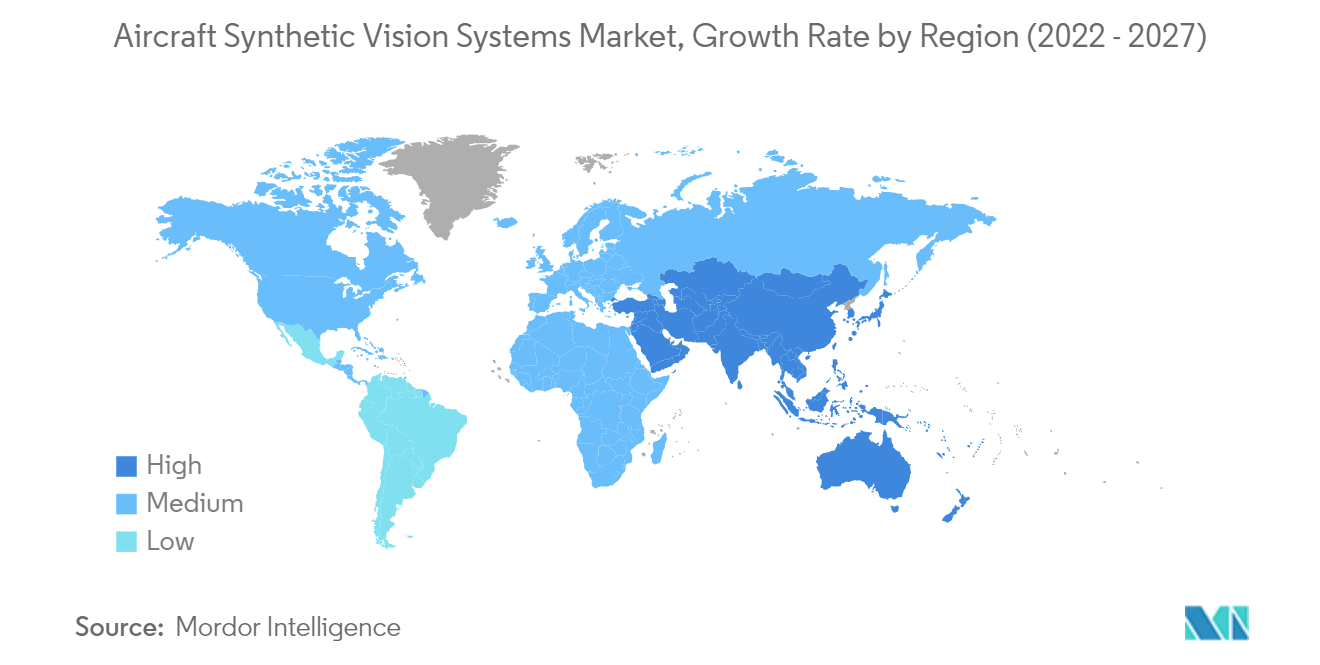Aircraft Synthetic Vision Systems Market Size

| Study Period | 2019 - 2029 |
| Base Year For Estimation | 2023 |
| CAGR | 2.80 % |
| Fastest Growing Market | Asia Pacific |
| Largest Market | North America |
| Market Concentration | Medium |
Major Players
*Disclaimer: Major Players sorted in no particular order |
Aircraft Synthetic Vision Systems Market Analysis
The aircraft synthetic vision systems market is expected to register a CAGR of 2.8%.
The global aviation sector was disrupted due to the COVID-19 pandemic. However, the sector recovered in 2021 and 2022. Due to the Covid-19 pandemic, the commercial aviation sector has been significantly affected, resulting in a drastic reduction in passenger traffic, negatively affecting aircraft demand. The military aviation sector remained stable and even grew as most countries have not reduced their defense budget and remain committed to sustaining their military capabilities. Nevertheless, due to the widespread supply chain disruption, some military aircraft programs faced minor cost escalations and delays.
The increasing demand for new aircraft drives the synthetic vision systems market as part of the fleet expansion and modernization programs initiated by respective end-users in the military, commercial, and general aviation sectors. Such factors will drive the market in the coming years.
Aircraft Synthetic Vision Systems Market Trends
This section covers the major market trends shaping the Aircraft Synthetic Vision Systems Market according to our research experts:
Military End-user to Witness Higher Growth During the Forecast Period
The emerging geopolitical rift among nations has fostered the need for the induction of advanced military assets, including aircraft. The subsequent increase in defense expenditure also aims to accelerate ongoing and new procurement programs for new-generation platforms. In 2021, the world military expenditure surpassed the two trillion US dollar mark for the first time, reaching USD 2,113 billion. Global spending in 2021 was 0.7% higher than in 2020 and 12% higher than in 2012.
Multiple prominent nations are procuring combat aircraft to strengthen their combat capabilities. For instance, in May 2021, the US Air Force awarded a USD 14 billion contract to Lockheed Martin Corporation to produce 128 Block 70/72 jets on behalf of Bahrain, Slovakia, Bulgaria, Taiwan, and Morocco. Similarly, in January 2021, the Indian Ministry of Defense (MoD) cleared the purchase of 83 LCA MK1A Tejas light combat aircraft for USD 6.5 billion. Also, in July 2021, the UK MoD signed a USD 347 million agreement with Team Tempest to provide digital and physical infrastructure to develop the aircraft. Other nations are undertaking similar procurement initiatives across the world. Since these new-generation military aircraft feature state-of-the-art synthetic vision systems that enable the pilot to have 360-degree situational awareness, the demand for new-generation military aircraft is expected to create a parallel demand for synthetic vision systems.

North America to Dominate the Market During the Forecast Period
The aerospace industry in the region is mature and strongly supported by a robust aviation base. Higher air traffic has resulted in the procurement of several aircraft by regional and international airline operators in the region. Boeing, one of the major aircraft OEMs based in the US, generates a huge demand for aircraft fire protection systems. As the OEMs receive new orders for aircraft, the demand is simultaneously generated for commercial aircraft fire protection systems, as FAA mandates the installation of evacuation systems in all active aircraft. Factors such as the availability of raw materials, political stability, and low production costs have driven the establishment of new aerospace manufacturing facilities in the region. Also, fluctuations in aviation fuel prices have triggered a surge in demand for fuel-efficient new-generation aircraft worldwide.
Hence, aircraft OEMs have started beefing up their production capabilities to cope with the ever-increasing demand. In September 2021, Airbus was developing a newly enhanced flight vision system (EFVS) for its A320 family of aircraft, which is expected to be adapted to other models eventually, and selections of a next-generation enhanced vision sensor to be supplied to Airbus by Collins Aerospace. The EFVS currently under development consists of the sensor, a multi-special camera system, head-up display (HUD), and cockpit controls, and eventually could be adapted to other Airbus aircraft models in addition to the A320.
Indigenous aircraft development programs are anticipated to bolster regional fire protection system manufacturers and integrators' business prospects. For instance, as part of its Air Superiority 2030 program, the US Air Force (USAF) is developing two new high-tech fighter aircraft, dubbed the Penetrating Counter Air. The USAF expects to ramp up funding to USD 1.4 billion in FY20 and USD 3.1 billion in 2022 for developing advanced air combat systems. Such investment and technological development are expected to boost the Aircraft Synthetic Vision Systems Market in the coming year.

Aircraft Synthetic Vision Systems Industry Overview
Major players in the aircraft synthetic vision systems market are Cobham Limited, Garmin Ltd, Honeywell International Inc., Thales Group, and Collins Aerospace (Raytheon Technologies Corporation). As synthetic vision systems (SVSs) become more mainstream, players are refining their products to appeal to a broader range of customers. Along with general aviation operators, key targets of the players include the rotorcraft and commercial aviation markets. However, for commercial and general aviation users, in addition to providing situational awareness, the market players are also expected to design synthetic vision systems keeping in mind the potential for economic returns. The systems are required to be less prone to malfunction or breakdown, eliminating or reducing the need for frequent upgrades and maintenance, which may attract new customers for players, helping them gain higher market shares.
Aircraft Synthetic Vision Systems Market Leaders
-
Garmin Ltd
-
Honeywell International Inc.
-
Thales Group
-
Cobham Limited
-
Collins Aerospace (Raytheon Technologies Corporation)
*Disclaimer: Major Players sorted in no particular order
.webp)
Aircraft Synthetic Vision Systems Market News
- In October 2022, Collins Aerospace achieved a technical standard order (TSO) for its combined vision system (CVS) for business aviation aircraft. The CVS provides clarity to pilots in all types of weather to confidently and securely navigate aircraft through low visibility situations.
- In October 2022, Garmin International Inc., a unit of Garmin Ltd, announced Supplemental Type Certification (STC) by the Federal Aviation Administration (FAA) for the GI 275 electronic flight instrument in the Dassault Falcon 7X business jet.
- In October 2021, Honeywell unveiled an all-new aircraft cockpit system for the first in the industry, built with an always-on, cloud-connected experience that improves flight efficiency, operations, safety, and comfort. The Honeywell Anthem flight deck offers unprecedented levels of connectivity, an exciting and intuitive interface modeled after everyday smart devices, and a highly scalable and customizable design.
Aircraft Synthetic Vision Systems Market Report - Table of Contents
1. INTRODUCTION
- 1.1 Study Assumptions
- 1.2 Scope of the Study
2. RESEARCH METHODOLOGY
3. EXECUTIVE SUMMARY
4. MARKET DYNAMICS
- 4.1 Market Overview
- 4.2 Market Drivers
- 4.3 Market Restraints
-
4.4 Industry Attractiveness - Porter's Five Forces Analysis
- 4.4.1 Threat of New Entrants
- 4.4.2 Bargaining Power of Buyers/Consumers
- 4.4.3 Bargaining Power of Suppliers
- 4.4.4 Threat of Substitute Products
- 4.4.5 Intensity of Competitive Rivalry
5. MARKET SEGMENTATION (Market Size by Value - USD million)
-
5.1 By Type
- 5.1.1 Primary Flight Display
- 5.1.2 Navigation Display
- 5.1.3 Heads-up and Helmet-mounted Display
- 5.1.4 Other Types
-
5.2 By End User
- 5.2.1 Military
- 5.2.2 Commercial
- 5.2.3 General Aviation
-
5.3 Geography
- 5.3.1 North America
- 5.3.1.1 United States
- 5.3.1.2 Canada
- 5.3.2 Europe
- 5.3.2.1 Germany
- 5.3.2.2 United Kingdom
- 5.3.2.3 France
- 5.3.2.4 Russia
- 5.3.2.5 Rest of Europe
- 5.3.3 Asia-Pacific
- 5.3.3.1 China
- 5.3.3.2 Japan
- 5.3.3.3 India
- 5.3.3.4 South Korea
- 5.3.3.5 Rest of Asia-Pacific
- 5.3.4 Latin America
- 5.3.4.1 Brazil
- 5.3.4.2 Mexico
- 5.3.4.3 Rest of Latin America
- 5.3.5 Middle East and Africa
- 5.3.5.1 United Arab Emirates
- 5.3.5.2 Saudi Arabia
- 5.3.5.3 Egypt
- 5.3.5.4 Rest of Middle East and Africa
6. COMPETITIVE LANDSCAPE
- 6.1 Vendor Market Share**
-
6.2 Company Profiles*
- 6.2.1 Cobham Limited
- 6.2.2 Garmin Ltd
- 6.2.3 Honeywell International Inc.
- 6.2.4 Thales Group
- 6.2.5 Collins Aerospace (Raytheon Technologies Corporation)
- 6.2.6 Safran SA
- 6.2.7 Aspen Avionics Inc.
- 6.2.8 Avidyne Corporation
- 6.2.9 Elbit Systems Ltd
- 6.2.10 Mercury Systems Inc.
- 6.2.11 L3Harris Technologies Inc.
- 6.2.12 ENSCO Inc.
7. MARKET OPPORTUNITIES AND FUTURE TRENDS
** Subject To AvailablityAircraft Synthetic Vision Systems Industry Segmentation
The aircraft synthetic vision system is an aircraft installation designed to improve the flight crew's situational awareness by combining 3D data into intuitive displays even in low visibility conditions using moving maps, artificial vision, and route planning hardware and software. The system also presents a computer-generated view of the external environment with a database of relevant information about the terrain, flight plan information, and runways to reduce the probability of an accident caused due to loss of control, runway incursion, and CFIT.
The Aircraft Synthetic Vision Systems Market is segmented based on Type, End-user, and Geography. By Type, the market is segmented into Primary Flight Displays, Navigation Displays, Heads-up and Helmet-mounted Displays, and Other Types. By End User, the market is segmented into Military, Commercial, and General Aviation, and by Geography into North America, Europe, Asia-Pacific, Latin America, and Middle East and Africa.
The report also covers the market sizes and forecasts for the aircraft synthetic vision system across major regions. For each segment, the market sizing and forecasts have been done based on value (USD Billion).
| By Type | Primary Flight Display | |
| Navigation Display | ||
| Heads-up and Helmet-mounted Display | ||
| Other Types | ||
| By End User | Military | |
| Commercial | ||
| General Aviation | ||
| Geography | North America | United States |
| Canada | ||
| Geography | Europe | Germany |
| United Kingdom | ||
| France | ||
| Russia | ||
| Rest of Europe | ||
| Geography | Asia-Pacific | China |
| Japan | ||
| India | ||
| South Korea | ||
| Rest of Asia-Pacific | ||
| Geography | Latin America | Brazil |
| Mexico | ||
| Rest of Latin America | ||
| Geography | Middle East and Africa | United Arab Emirates |
| Saudi Arabia | ||
| Egypt | ||
| Rest of Middle East and Africa |
Aircraft Synthetic Vision Systems Market Research FAQs
What is the current Aircraft Synthetic Vision Systems Market size?
The Aircraft Synthetic Vision Systems Market is projected to register a CAGR of greater than 2.80% during the forecast period (2024-2029)
Who are the key players in Aircraft Synthetic Vision Systems Market?
Garmin Ltd, Honeywell International Inc., Thales Group, Cobham Limited and Collins Aerospace (Raytheon Technologies Corporation) are the major companies operating in the Aircraft Synthetic Vision Systems Market.
Which is the fastest growing region in Aircraft Synthetic Vision Systems Market?
Asia Pacific is estimated to grow at the highest CAGR over the forecast period (2024-2029).
Which region has the biggest share in Aircraft Synthetic Vision Systems Market?
In 2024, the North America accounts for the largest market share in Aircraft Synthetic Vision Systems Market.
What years does this Aircraft Synthetic Vision Systems Market cover?
The report covers the Aircraft Synthetic Vision Systems Market historical market size for years: 2019, 2020, 2021, 2022 and 2023. The report also forecasts the Aircraft Synthetic Vision Systems Market size for years: 2024, 2025, 2026, 2027, 2028 and 2029.
Aircraft Synthetic Vision Systems Industry Report
Statistics for the 2024 Aircraft Synthetic Vision Systems market share, size and revenue growth rate, created by Mordor Intelligence™ Industry Reports. Aircraft Synthetic Vision Systems analysis includes a market forecast outlook to 2029 and historical overview. Get a sample of this industry analysis as a free report PDF download.



